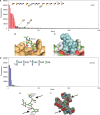Structural insights into what glycan arrays tell us about how glycan-binding proteins interact with their ligands
- PMID: 19528664
- PMCID: PMC2757572
- DOI: 10.1093/glycob/cwp076
Structural insights into what glycan arrays tell us about how glycan-binding proteins interact with their ligands
Abstract
Screening of glycan arrays represents a powerful, high-throughput approach to defining oligosaccharide ligands for glycan-binding receptors, commonly referred to as lectins. Correlating results from such arrays with structural analysis of receptor-ligand complexes provide one way to validate the arrays. Using examples drawn from the family of proteins that contain C-type carbohydrate-recognition domains, this review illustrates how information from the arrays reflects the way that selectivity and affinity for glycan ligands is achieved. A range of binding profiles is observed, from very restricted binding to a small set of structurally similar ligands to binding of broad classes of ligands with related terminal sugars and even to failure to bind any of the glycans on an array. These outcomes provide insights into the importance of multiple factors in defining the selectivity of these receptors, including the presence of conformationally defined units in some oligosaccharide ligands, local and extended interactions between glycans and the surfaces of receptors, and steric factors that exclude binding of some ligands.
Figures



References
-
- Bochner BS, Alvarez RA, Mehta P, Bovin NV, Blixt O, White JR, Schnaar RL. Glycan array screening reveals a candidate ligand for siglec-8. J Biol Chem. 2005;280:4307–4312. - PubMed
-
- Coombs PJ, Graham SA, Drickamer K, Taylor ME. Selective binding of the scavenger receptor C-type lectin to Lewisx trisaccharide and related glycan ligands. J Biol Chem. 2005;280:22993–22999. - PubMed
-
- Engering A, Geijtenbeek TBH, van Vliet SJ, Wijers M, van Liempt E, Demaurex N, Lanzacecchia A, Fransen J, Figdor CG, Piguet V, et al. The dendritic cell-specific adhesion receptor DC-SIGN internalizes antigen for presentation to T cells. J Immunol. 2002;168:2118–2126. - PubMed
Publication types
MeSH terms
Substances
Grants and funding
LinkOut - more resources
Full Text Sources
Other Literature Sources

